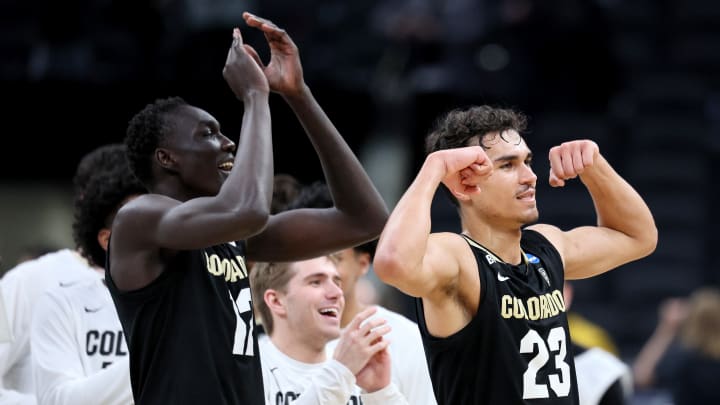How Much Stock Should A Team Put Into A Good NCAA Tournament Performance?

In this story:
The NCAA Tournament is upon us, and like every year the tourney raises a draft-related question: Just how much stock should we put into a player having a good, or bad, tournament compared to the rest of his season?
The answer, like every year, isn't as straightforward as many might believe it is. So let's take a look at it.
Performing well in the NCAA Tournament is always a good thing, as it can never hurt a player's draft projection. Even if the player has a three-week period of ridiculously high-level play, after a regular season of showing very little of it, that at least presents interested NBA teams with a new dataset that they can pull apart, and work from.
Thus, even if they come to the conclusion that the player isn't going to move up or down their draft board, they at least saw something different from the player, which will taken into their future considerations.
What's important to note for teams is this: Falling in love with a player based on an extremely small sample size will always be dangerous waters, regardless of how you slice it.
In 2006, the Chicago Bulls fell in love with LSU forward Tyrus Thomas. One game that was often referenced in their rationale of selecting the 6-foot-9 forward was how he'd scored 21 points, and grabbed 13 rebounds, in a huge win over Texas, where he kept fellow prospect LaMarcus Aldridge to four points on 2-of-14 shooting.
The Bulls were right in identifying Thomas as the better player in that particular game, but made an egregious mistake by actually selecting Aldridge second overall, only to trade down for Thomas, thus relinquishing the better player as we now know.
Basically, the Bulls became prisoners of a single moment.
They ignored that Aldridge had been far more productive in college that season. They ignored his game was better put together from a perspective of skill and feel. They ignored he was taller, and knew how to take better advantage of his height. They ignored that Aldridge - unlike Thomas, who fancied himself as the next Tracy McGrady - was perfectly fine with the role of being a big man.
The idea for the Bulls was that a guy who could play in such a way, in such an important game, would figure it out.
While there might be an inkling of logic in such an approach, it's extremely difficult to peg down a full career off one game that lasts around two hours.
Now, I do wish to be fair to Thomas. He was a decade ahead of his time. In today's switching-heavy defensive schemes, Thomas might genuinely have developed into a Defensive Player Of the Year candidate. His desire of playing more on the perimeter would have even been welcomed, instead of rejected as it was in 2006.
Thomas wasn't a bad player. Not even close. But at the time he was the exact opposite of a plug and play guy, given the way basketball was played then. Aldridge, on the other hand, was far easier to implement due to his skills as a shooter, and feathery touch around the rim.
The decision to swing on Thomas backfired on the Bulls, and tremendously so. It took them back years, and were bailed out by winning the Derrick Rose lottery two years later with a 1.7% chance.
In today's NBA, whiffing on a draft pick is still a regular occurrence, but at least most teams use better logic when making their selections. Teams take a more holistic approach to evaluating players, where the regular season matters even more than just a strong finish to the season.
So, when should players lean in on a guy who suddenly starts producing like a star when the games begin to truly matter?
Two scenarios stick out.
The first being the case of a team having a group of players on a similar tier heading into the tournament, where one of them ends up standing out. Under such circumstances, it's entirely fair to use the tournament as another layer in the ultimate decision-making process.
The second scenario is even more simplistic. If a team is already in on a player, and that player is high on their draft board, it's fine if quality play in the tourney cements the decision for that team. That's a reasonable way to reach a conclusion.
Where things can go south, and quickly, is if a team is - at best - lukewarm on a guy after the regular season, and does a 180 after a good tournament. If you didn't love the guy after 30 games, but love him after three, your evaluation process is flawed and has nothing even resembling a foundation.
Fortunately, teams continue to get smarter. Scouts are spending the full season gathering crucial intel, including background checks, and teams now arrive at the draft far more prepared than just the prior year.
That doesn't mean every team walks away with a home run selection. But at least their approach is getting increasingly better.
Unless noted otherwise, all stats via NBA.com, PBPStats, Cleaning the Glass or Basketball-Reference. All salary information via Spotrac. All odds courtesy .
Want to join the discussion? Like Draft Digest on Facebook and follow us on Twitter to stay up to date on all the latest NBA Draft news. You can also meet the team behind the coverage.

Morten has managed to create a stable career for himself, launching Denmark's first weekly NBA radio show, and co-hosting a weekly NBA TV show. He's a seasoned basketball analyst and is experienced covering the league and its upcoming prospects.
Follow msjnba